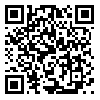BibTeX | RIS | EndNote | Medlars | ProCite | Reference Manager | RefWorks
Send citation to:
URL: http://rehabilitationj.uswr.ac.ir/article-1-82-en.html

 , Yousef Shafaghati
, Yousef Shafaghati 
 , Elaheh Keyhani
, Elaheh Keyhani 
 , Mandana Hassan-Zad
, Mandana Hassan-Zad 
 , Mojtaba A'zimiyan
, Mojtaba A'zimiyan 
 , Fereidoun Layeghi
, Fereidoun Layeghi 
 , Afshin Vojdani-Rowshan
, Afshin Vojdani-Rowshan 
 , John Andoni-Ortizbera
, John Andoni-Ortizbera 
 , Daniel Hentay
, Daniel Hentay 
 , Hossein Najm-Abadi
, Hossein Najm-Abadi 

Objective: Neuromuscular disordres are a gorup of heterogenous inherited diseases. More than 150 types of these group of disorders have been known.The criticals that were used for classification of these disease include: age of onset, clinical course, disease progression and type of inheritance. Neuromuscular disorders have been classified in four categories: Myopaties (Muscular dystrophies) Neuropathy (Charcot-Marie-Tooth dieseas), Motor neuron junction (Myasthenia Syndrome) Motor neuron disorder (Spinal muscular atrophy). Objective of this study was classification of neuromuscular disorders based on clinical criteria, molecular and immunohistochemical analysis that reffered to Genetic Research Center. As a result of neuromuscular disorders was the second most common disabilities, more investigation in this group of disorders is necessary in Iranian population so this study was performed for the first time in Iranian patients.
Materials & Methods: Total of 143 patient with neuromuscular deficiency that clinical, EMG and muscle enzymes have been tested and also in some cases molecular and immunohistochemical analysis was performed.
Results: 82 patients with myotonic dystrophy, 19 patients with DMD/BMD, 6 patients with congenital muscular dystrophy, 3 patients with FSHD, 10 patients with SMA, 2 patients with CMS and 21 patients with LGMD. For the other cases we need more molecular and definite clinical analysis.
Conclusion: For some cases that DM1 was not confirmed, study of DM2 is recommended. In patients with LGMD that analysis with 5 Abs were normal we advised multiple western blot for them (including calpain, sarcoglycans, dysferlin). Study of congenital muscular dystrophy besides merosin analysis, investigation for the other involved protein and molecular testing for mutation detection is considrable.
Received: 4/09/2007 | Accepted: 10/10/2015 | Published: 10/10/2015
| Rights and permissions | |
 |
This work is licensed under a Creative Commons Attribution-NonCommercial 4.0 International License. |



